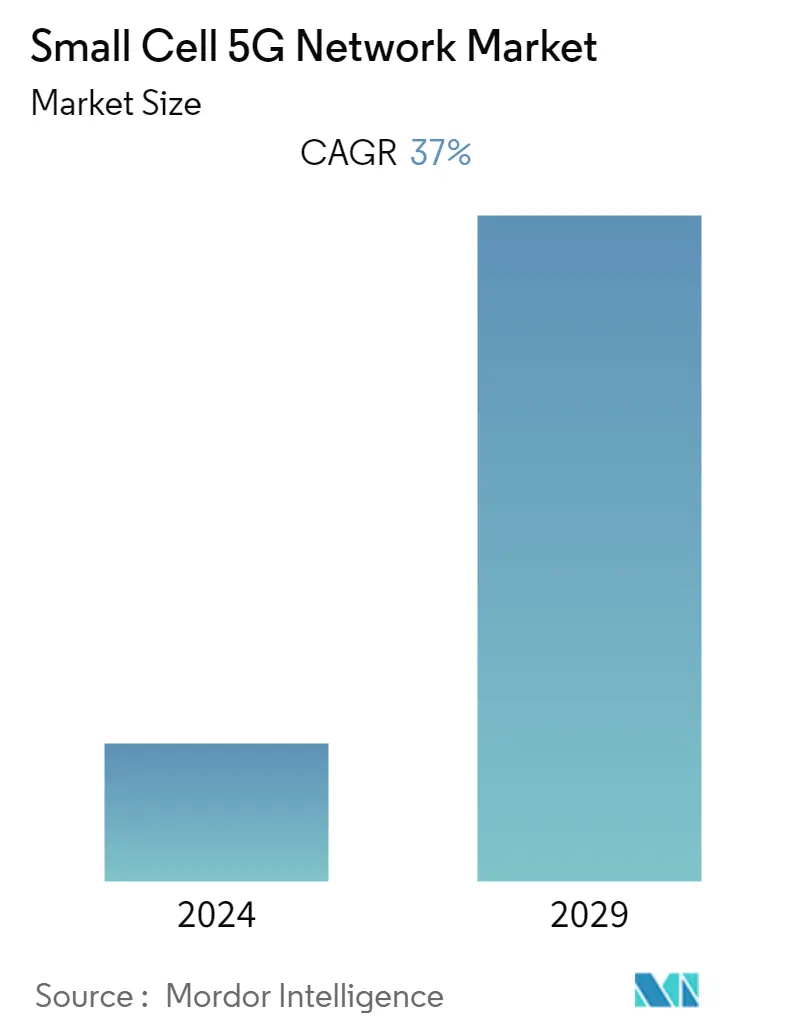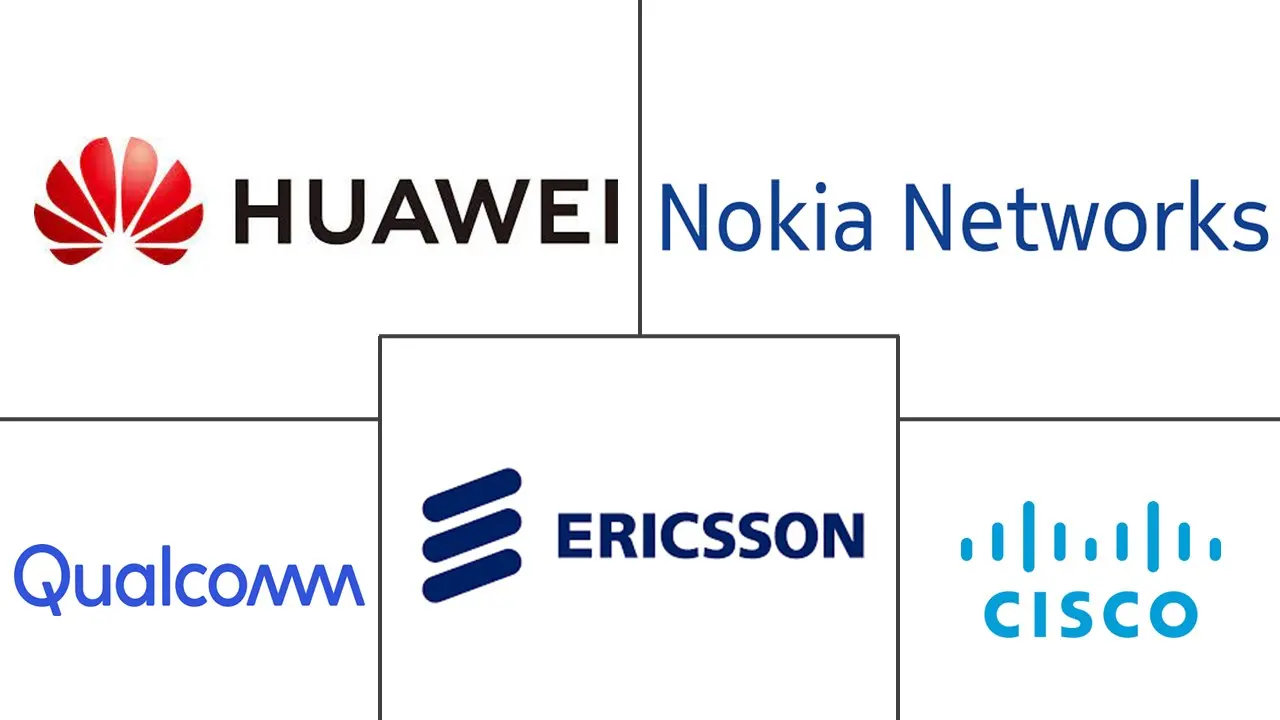Market Size of Small Cell 5G Network Industry

| Study Period | 2019 - 2029 |
| Base Year For Estimation | 2023 |
| CAGR (2024 - 2029) | 37.00 % |
| Fastest Growing Market | Asia Pacific |
| Largest Market | North America |
| Market Concentration | Medium |
Major Players
*Disclaimer: Major Players sorted in no particular order |
Small Cell 5G Network Market Analysis
The Small Cell 5G Network Market is expected to register a CAGR of 37% during the forecast period(2024-2029).
- Small cells are expected to be the foundation of future global 5G networks. The deployment of 5G small cells at a large scale and required speed worldwide is made possible by industry coordination, making 5G a reality. Although 5G promises to be cheaper and faster, it requires expanding the wireless network using small cells.
- Small cells are essential in the current environment, particularly for applications that demand more bandwidth and the growing number of connected devices. For example, Cisco Systems Inc predicts that 500 billion devices will be online by 2030. Additionally, 5G telecom providers are focused on installing small cells in low-frequency bands to provide customers better coverage.
- The increasing mobile data traffic is driving the market growth. According to the Cisco Visual Networking Index (VNI), global mobile data traffic increased at a CAGR of 46% from 2017 to last year, reaching 77.5 exabytes per month. In the previous year, a 5G connection produced around 2.6 times as much traffic as the typical 4G connection, according to Cisco's study.
- Small cell deployment is a top priority for various operators, with 60% of operators believing them to be a crucial component of their 4G services. Leading carriers such as Vodafone, AT&T, and Softbank have already implemented small-cell technologies in addition to their macro networks. For example, Verizon has installed small cells in several US cities, including New York, Chicago, Atlanta, and San Francisco.
- In addition, 5G can be deployed on existing cellular radio frequencies but may enable operators to use higher radio frequencies (over 20 GHz) to make it operable, especially for mobile services. However, deployment at these frequencies is only possible in constrained areas, and signal penetration is restricted as it does not go through walls. This increases the adoption of small cells for in-building applications, with excellent connectivity for smartphones and IoT devices.
- The COVID-19 outbreak had a significant impact on the mobile sector. In the short term, the 5G rollout in several markets will be further delayed, and its services will be the hardest hit. Consumers may be unable to spend on small cell 5G devices as it is still considered a niche market. According to Groupe Speciale Mobile Association (GSMA) Intelligence's consumer survey, most respondents had limited interest in upgrading to 5G services. For instance, according to the report, nearly 80% of consumers in the United Kingdom did not plan to upgrade.
Small Cell 5G Network Industry Segmentation
Small cells are low-power, short-range wireless transmission systems primarily designed to serve indoor and outdoor applications or a restricted geographic area. Small cells are crucial to delivering low-latency apps and high-speed mobile broadband in 5G deployments. Small cells are further classified into subcategories like a microcell, metro cells, picocells, and femtocells based on their coverage area and user capacity. Telecom operators, households, and businesses are among the small cell's end users.
The small cell 5g network market is segmented by operating environment (indoor, outdoor), end-user vertical (telecom operators, enterprises, residential), and geography (North America, Europe, Asia Pacific, and the Rest of the World).
The market sizes and forecasts are provided in terms of value (USD) for all the above segments.
| By Operating Environment | |
| Indoor | |
| Outdoor |
| By End-User Vertical | |
| Telecom Operators | |
| Enterprises | |
| Residential |
| By Geography | |
| North America | |
| Europe | |
| Asia Pacific | |
| Rest of the World |
Small Cell 5G Network Market Size Summary
The Small Cell 5G Network Market is poised for significant growth, driven by the increasing demand for enhanced mobile data traffic and the proliferation of connected devices. Small cells are becoming the backbone of future 5G networks, enabling faster and more cost-effective deployments. These compact infrastructure components are crucial for applications requiring high bandwidth and low latency, supporting the dense population of IoT devices and smartphones. Telecom operators worldwide are prioritizing small cell technology to expand their 5G coverage, with major players like Vodafone, AT&T, and Softbank already integrating these solutions into their networks. The market is further bolstered by strategic partnerships and technological advancements, such as Nokia's collaboration with Chunghwa Telecom in Taiwan, which aims to enhance 5G coverage through innovative small cell solutions.
North America leads the market, with telecom operators in the United States aggressively deploying small cells to densify their 5G networks, particularly in urban areas. Companies like Verizon and T-Mobile are investing heavily in small cell infrastructure to improve coverage and reduce costs. The market is moderately consolidated, with key players like Nokia Networks, Cisco Systems Inc., and Qualcomm Technologies Inc. driving innovation through product development and strategic alliances. Recent developments, such as Samsung's Strand Small Cell and Vodafone's partnership with Nokia for a 5G Open RAN pilot, highlight the ongoing efforts to expand 5G capabilities and foster a competitive ecosystem. As the demand for high-speed data continues to rise, the small cell 5G network market is expected to experience robust growth, supported by technological advancements and strategic collaborations.
Small Cell 5G Network Market Size - Table of Contents
-
1. MARKET INSIGHTS
-
1.1 Market Overview
-
1.2 Industry Attractiveness - Porter's Five Forces Analysis
-
1.2.1 Bargaining Power of Suppliers
-
1.2.2 Bargaining Power of Consumers
-
1.2.3 Threat of New Entrants
-
1.2.4 Threat of Substitutes
-
1.2.5 Intensity of Competition
-
-
1.3 Impact of COVID-19 on the Market
-
-
2. MARKET SEGMENTATION
-
2.1 By Operating Environment
-
2.1.1 Indoor
-
2.1.2 Outdoor
-
-
2.2 By End-User Vertical
-
2.2.1 Telecom Operators
-
2.2.2 Enterprises
-
2.2.3 Residential
-
-
2.3 By Geography
-
2.3.1 North America
-
2.3.2 Europe
-
2.3.3 Asia Pacific
-
2.3.4 Rest of the World
-
-
Small Cell 5G Network Market Size FAQs
What is the current Small Cell 5G Network Market size?
The Small Cell 5G Network Market is projected to register a CAGR of 37% during the forecast period (2024-2029)
Who are the key players in Small Cell 5G Network Market?
Nokia Networks, Qualcomm Technologies Inc., Huawei Technologies Co. Ltd, Telefonaktiebolaget LM Ericsson and Cisco Systems Inc. are the major companies operating in the Small Cell 5G Network Market.

